Part A. Analyse the difference between the quantitative approach
Added on 2022-10-01
51 Pages13113 Words24 Views
Part A
Analyse the difference between the quantitative approach and the qualitative approach on the
following criteria-goal, method ,data collection, techniques, sample generalisation ,analysis and
the role of researcher.
There are two of the basic approaches towards the collection of data in a research study. These
are qualitative research and quantitative research. However there exist a fundamental difference
among the two types of research data. This section of the essay will highlight on the distinction
among qualitative and quantitative approach in every possible aspect during the research study
by a researcher.
Qualitative research is connected with the development of explanation of social phenomenon.
This research helps to understand the world where individuals live. This research approach is
concerned with the social aspects of the world. Quantitative research on the other hand
emphasizes over the measurement of objects and the mathematical, statistical or numerical
analysis of the information collected in the research through question as and service or by the
means of the manipulation of Pre existing data by the use of computational techniques (Taylor,
Bogdan & DeVault, 2015). It is the tendency of qualitative research to focus on collecting
numerical data and for the more generalizing it across a wide group of people for the explanation
of a particular phenomena.
Some of the basic characteristics of qualitative research includes subjectivity, holistic nature,
phenomenological traits, anti positivist, descriptive, inductive and naturalistic.
On the other hand some of the fundamental characteristics of quantitative research includes
objectivity, reductionist, scientific, positivist, experimental, deductive and contrived nature.
Analyse the difference between the quantitative approach and the qualitative approach on the
following criteria-goal, method ,data collection, techniques, sample generalisation ,analysis and
the role of researcher.
There are two of the basic approaches towards the collection of data in a research study. These
are qualitative research and quantitative research. However there exist a fundamental difference
among the two types of research data. This section of the essay will highlight on the distinction
among qualitative and quantitative approach in every possible aspect during the research study
by a researcher.
Qualitative research is connected with the development of explanation of social phenomenon.
This research helps to understand the world where individuals live. This research approach is
concerned with the social aspects of the world. Quantitative research on the other hand
emphasizes over the measurement of objects and the mathematical, statistical or numerical
analysis of the information collected in the research through question as and service or by the
means of the manipulation of Pre existing data by the use of computational techniques (Taylor,
Bogdan & DeVault, 2015). It is the tendency of qualitative research to focus on collecting
numerical data and for the more generalizing it across a wide group of people for the explanation
of a particular phenomena.
Some of the basic characteristics of qualitative research includes subjectivity, holistic nature,
phenomenological traits, anti positivist, descriptive, inductive and naturalistic.
On the other hand some of the fundamental characteristics of quantitative research includes
objectivity, reductionist, scientific, positivist, experimental, deductive and contrived nature.
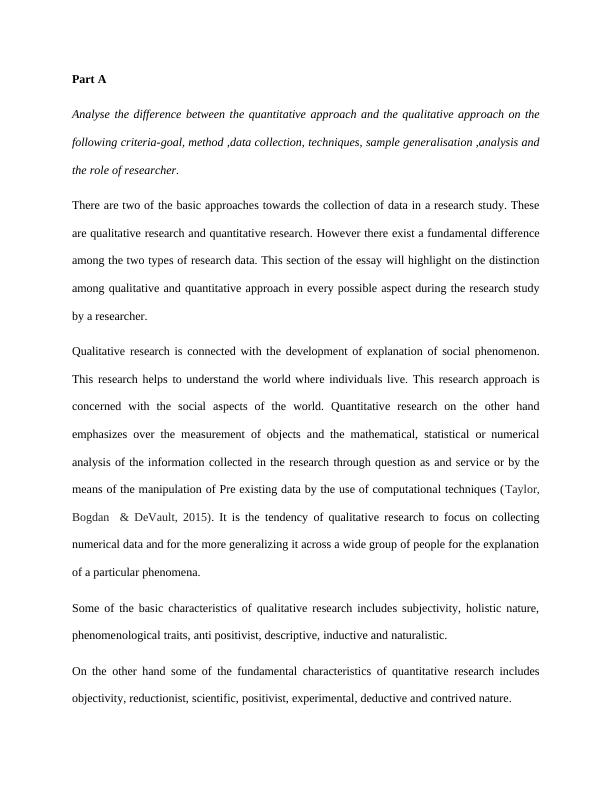
Goal
In the context of the goal of qualitative approach it can be stated that these includes ethnography,
grounded theory, phenomenology and case study. Another common design for the goal of the
research is survey. The four major type of qualitative research approach aims to derive better
understanding derived from variety of traditions and disciplines. The goal of qualitative research
method is to learn directly and deep towards certain situation why observation and recording of
feelings, attitudes and behaviours (Newman, Benz & Ridenour, 1998) Qualitative research is one
of the form of the enquiry which targets towards analysis of information which are conveyed
through the behaviour or the language as per the natural settings. The goal of the qualitative
research is to capture expressive data which are not conveyed in quantitative data regarding
values, believes, feelings as well as motivations that underlie the behaviours.
On the other hand the four major type of quantitative research design and their goal includes
correlational, descriptive, experiment and quasi experimental research. The goal of quantitative
research study is towards the determination of the connection or the relationship between an
independent variable and another dependent variable within the sample population. Quantitative
research focuses on counting and the classification of the features together with the construction
of statistical figures and models for the explanation of what is observed and collected (Allwood,
2012). Quantitative research is mainly used or the goal of this research is to quantify the
challenges by the way towards the generation of numerical data for the data that can be
transformed to statistics. Quantitative research is used to behaviour, opinions and other define
variables to generalize result from a larger population sample.
Method
In the context of the goal of qualitative approach it can be stated that these includes ethnography,
grounded theory, phenomenology and case study. Another common design for the goal of the
research is survey. The four major type of qualitative research approach aims to derive better
understanding derived from variety of traditions and disciplines. The goal of qualitative research
method is to learn directly and deep towards certain situation why observation and recording of
feelings, attitudes and behaviours (Newman, Benz & Ridenour, 1998) Qualitative research is one
of the form of the enquiry which targets towards analysis of information which are conveyed
through the behaviour or the language as per the natural settings. The goal of the qualitative
research is to capture expressive data which are not conveyed in quantitative data regarding
values, believes, feelings as well as motivations that underlie the behaviours.
On the other hand the four major type of quantitative research design and their goal includes
correlational, descriptive, experiment and quasi experimental research. The goal of quantitative
research study is towards the determination of the connection or the relationship between an
independent variable and another dependent variable within the sample population. Quantitative
research focuses on counting and the classification of the features together with the construction
of statistical figures and models for the explanation of what is observed and collected (Allwood,
2012). Quantitative research is mainly used or the goal of this research is to quantify the
challenges by the way towards the generation of numerical data for the data that can be
transformed to statistics. Quantitative research is used to behaviour, opinions and other define
variables to generalize result from a larger population sample.
Method
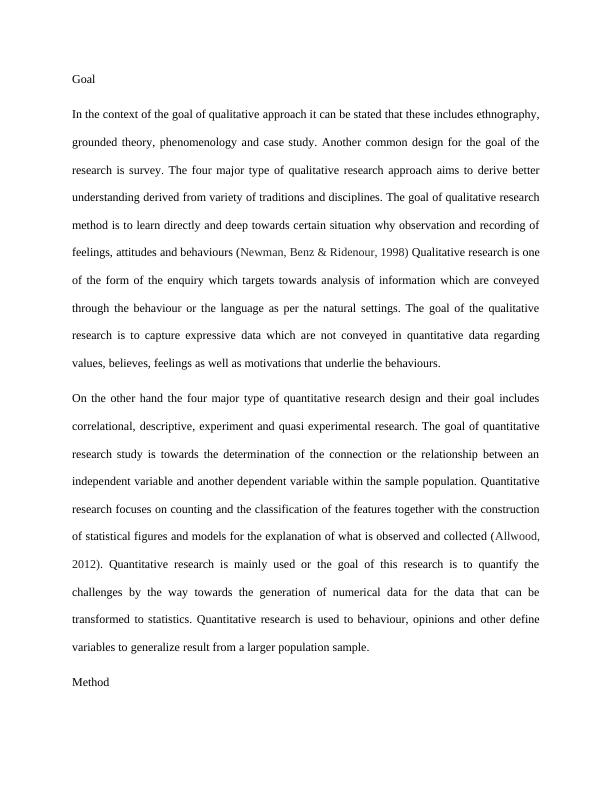
The key differences among the qualitative and the quantitative research methods is the context of
flexibility. In case of qualitative research, the methods that are mostly used are the action
research, the ethnography, content analysis, qualitative case study and so forth. The method of
the qualitative research is conducted with in depth perceptions as well as description of the
places, events and targeted population.
Quantitative research on the other hand includes the common research method which are surveys
and experiments (Choy, 2014). Correlative data are also collected in the written form at this
research method by answering from face to face interviews and questionnaires.
Data collection techniques
Regarding data collection technique, within the qualitative research, the tool is the human
instrument while taking in consideration of the total context. There are several methods that are
used in data collection of the qualitative research. Some of the most common are the group
discussions, interviews, documental analysis and observational method. On the other hand, in the
quantitative research, the main tool for the collection of data are the scales, questionnaire, tests or
ant inventories (Antwi & Hamza, 2015). Quantitative research data collection method rely over
random sampling and the structured data collection tool which fits some of the diverse
experiences towards response categories that are pre-determined in nature.
Sample
In the context of the sample size, in qualitative research, the size of the sample is small and is
generally not chosen on a random basis. At the qualitative research method, there are several
categories of sampling techniques that can be used for the interpretation of the collected data set.
The two of the most popular sampling techniques are convenience sampling and purposeful
flexibility. In case of qualitative research, the methods that are mostly used are the action
research, the ethnography, content analysis, qualitative case study and so forth. The method of
the qualitative research is conducted with in depth perceptions as well as description of the
places, events and targeted population.
Quantitative research on the other hand includes the common research method which are surveys
and experiments (Choy, 2014). Correlative data are also collected in the written form at this
research method by answering from face to face interviews and questionnaires.
Data collection techniques
Regarding data collection technique, within the qualitative research, the tool is the human
instrument while taking in consideration of the total context. There are several methods that are
used in data collection of the qualitative research. Some of the most common are the group
discussions, interviews, documental analysis and observational method. On the other hand, in the
quantitative research, the main tool for the collection of data are the scales, questionnaire, tests or
ant inventories (Antwi & Hamza, 2015). Quantitative research data collection method rely over
random sampling and the structured data collection tool which fits some of the diverse
experiences towards response categories that are pre-determined in nature.
Sample
In the context of the sample size, in qualitative research, the size of the sample is small and is
generally not chosen on a random basis. At the qualitative research method, there are several
categories of sampling techniques that can be used for the interpretation of the collected data set.
The two of the most popular sampling techniques are convenience sampling and purposeful
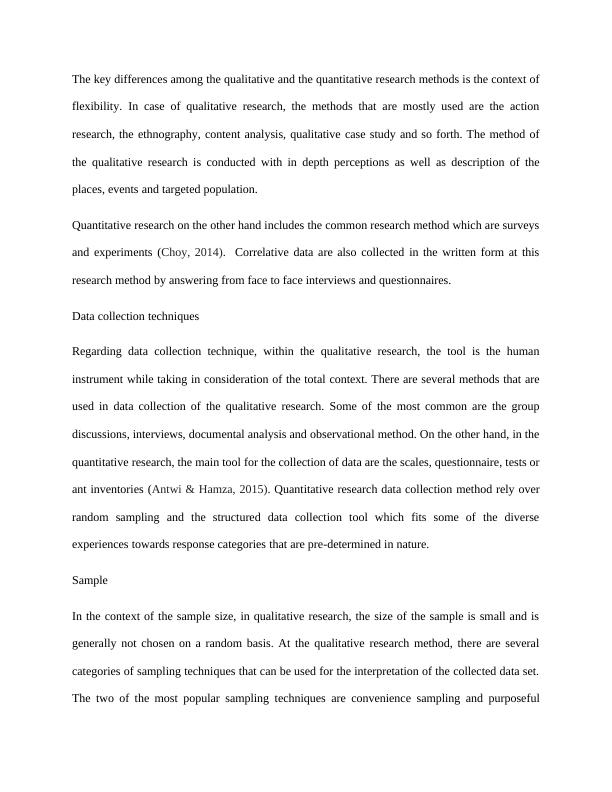
sampling due to the reason that they align the best within the qualitative research design
(Bernard, 2017). On the other hand, in the quantitative research, the sample needs to be large
enough for the representation of the population. Furthermore, the size of the sample might get
determined by the statistics due to the requirement of statistical tools for making certain size of
the sample to stand as effective.
Generalisation
In the context of the qualitative research, the subjects or the cases are being selected on the basis
of uniqueness or the unique case selection. The generalization of the findings is not a factor to
concern in this type of research (Mayer, 2015). On the other hand at the quantitative research, the
findings that re being collected from the population sample are being generalised for concluding
the research study.
Analysis
The qualitative research study adopts the inductive approach due to the lack of the existing
theories. This research study are unable towards effective explanation of the convincing
phenomenon. Due to this reason, no hypotheses are generally put forward for the guidance of the
research. In the qualitative research study, the researcher observes the phenomenon and
furthermore continues towards identifying patterns at the forms of categories, themes and
emerging typologies (Brannen, 2017). Within the qualitative research method, tentative
hypothesis are being introduced and also additional data are being gathered for the effective
explanation of the phenomenon.
On the other hand, the quantitative analysis is objective oriented in nature. The analysis of
quantitative approach is associated with the analysis of the numeric where data or the
(Bernard, 2017). On the other hand, in the quantitative research, the sample needs to be large
enough for the representation of the population. Furthermore, the size of the sample might get
determined by the statistics due to the requirement of statistical tools for making certain size of
the sample to stand as effective.
Generalisation
In the context of the qualitative research, the subjects or the cases are being selected on the basis
of uniqueness or the unique case selection. The generalization of the findings is not a factor to
concern in this type of research (Mayer, 2015). On the other hand at the quantitative research, the
findings that re being collected from the population sample are being generalised for concluding
the research study.
Analysis
The qualitative research study adopts the inductive approach due to the lack of the existing
theories. This research study are unable towards effective explanation of the convincing
phenomenon. Due to this reason, no hypotheses are generally put forward for the guidance of the
research. In the qualitative research study, the researcher observes the phenomenon and
furthermore continues towards identifying patterns at the forms of categories, themes and
emerging typologies (Brannen, 2017). Within the qualitative research method, tentative
hypothesis are being introduced and also additional data are being gathered for the effective
explanation of the phenomenon.
On the other hand, the quantitative analysis is objective oriented in nature. The analysis of
quantitative approach is associated with the analysis of the numeric where data or the
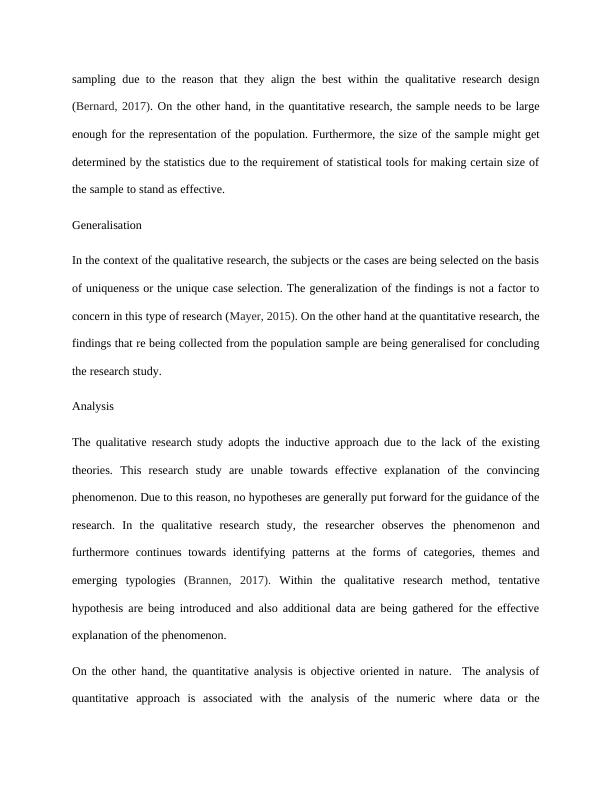
information are being collected, classified and then computed for the research discussion with
the use of numerous set of statistical method. The analysis with the quantitative approach is
concerned with the measurable quantities like length, weight, speed, temperature, width and
speed. The quantitative research approach adopts deductive approach for analysis of the data.
Role of the researcher
While conducting research with qualitative research approach, it is important for the researcher
to physically travel to the location, reach people, the site or the settings, specifically the field for
conducting effective observation, interview as well as collecting relevant information and
documents and artefacts that are necessary for conducting the research study (Creswell & Poth,
2016). Qualitative research approach is naturalistic in nature where the researcher play a very
important role by immersing himself to the situation rather than manipulating the situation. The
researcher in this approach observe the natural activities and collect the real data.
In case of the quantitative approach towards the data collection, the researcher often gets
detached and manipulates the situation while conducting any experiment for the research study.
Thus it can be concluded from the above discussion that both qualitative and quantitative
research approach are essential while conducting research studies depending on the type of
sample, method and research aspect. While the qualitative research approach relies mostly over
the narrative or and verbal data like written or spoken data, the quantitative research approach
generally depends on statistical and logical observations for drawing relevant conclusion. The
nature of the qualitative research approach is holistic while the quantitative research approach is
particularistic in nature (McCusker & Gunaydin, 2015). The approach for the qualitative research
approach is subjective while that of the quantitative approach is objective in nature. In the
the use of numerous set of statistical method. The analysis with the quantitative approach is
concerned with the measurable quantities like length, weight, speed, temperature, width and
speed. The quantitative research approach adopts deductive approach for analysis of the data.
Role of the researcher
While conducting research with qualitative research approach, it is important for the researcher
to physically travel to the location, reach people, the site or the settings, specifically the field for
conducting effective observation, interview as well as collecting relevant information and
documents and artefacts that are necessary for conducting the research study (Creswell & Poth,
2016). Qualitative research approach is naturalistic in nature where the researcher play a very
important role by immersing himself to the situation rather than manipulating the situation. The
researcher in this approach observe the natural activities and collect the real data.
In case of the quantitative approach towards the data collection, the researcher often gets
detached and manipulates the situation while conducting any experiment for the research study.
Thus it can be concluded from the above discussion that both qualitative and quantitative
research approach are essential while conducting research studies depending on the type of
sample, method and research aspect. While the qualitative research approach relies mostly over
the narrative or and verbal data like written or spoken data, the quantitative research approach
generally depends on statistical and logical observations for drawing relevant conclusion. The
nature of the qualitative research approach is holistic while the quantitative research approach is
particularistic in nature (McCusker & Gunaydin, 2015). The approach for the qualitative research
approach is subjective while that of the quantitative approach is objective in nature. In the

consideration of the research type, the qualitative research approach is exploratory in nature
while that of quantitative research approach is conclusive in nature. The sampling approach for
qualitative approach is purposive while quantitative approach is random in nature (Newman,
Benz & Ridenour, 1998). The objectives of the qualitative approach in the research study is to
explore as well as discover the ideas that are used within the process. On the other hand, for the
quantitative approach in research, the objective is to examine the reason as well as the impact of
the relation among the variables.
while that of quantitative research approach is conclusive in nature. The sampling approach for
qualitative approach is purposive while quantitative approach is random in nature (Newman,
Benz & Ridenour, 1998). The objectives of the qualitative approach in the research study is to
explore as well as discover the ideas that are used within the process. On the other hand, for the
quantitative approach in research, the objective is to examine the reason as well as the impact of
the relation among the variables.
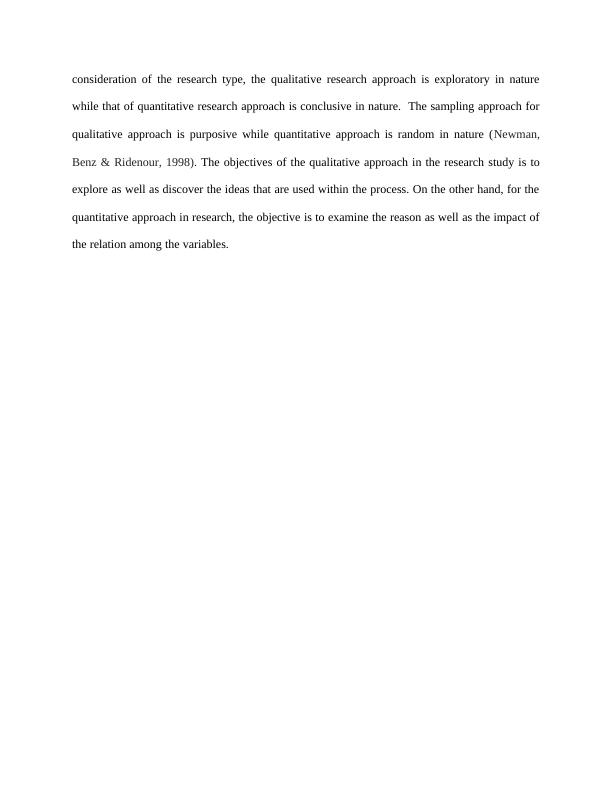
Part B
Coding is the process of examining raw qualitative data in the form of words, phrases, sentences
or paragraphs and assigning codes or labels. Explain with examples.
Coding is the universal procedure within the qualitative research process and one of the
fundamental aspect of the process of analytics by which the researcher breaks down and
interprets the data or information for developing something new or innovative. According to
Creswell (2015), coding can be illustrated as the process for the effective analysis of the
qualitative data set by breaking them for identification of the authenticity and the usefulness of
the data before putting the data set back together at a meaningful way.
Towards the examination of the raw qualitative data set, coding is executed with the help of
phrases, word and sentences followed by assigning of the codes as well as the labels. Here are
two broad categories of coding that is used in the examination of the qualitative data set in the
research are the open coding and the axial coding (Theron, 2015). Open coding is the label or
the code that is found within the texts or transcripts. The axial coding is the categories by the
means of grouping labels or codes for phrases or words. Axial coding can again be subdivide in
two types ; the non-hierarchical and hierarchical level. Some of the examples of the codes or
labels in the non-hierarchal axial coding category, also termed as flat coding are as follows.
Category – Taking break from daily work by the adults;
Code – Going out for work, taking a nap, following any of his hobby, taking a holiday and more.
In the context of the hierarchal coding, numerous codes group together and make their own sub
codes. Hierarchal coding is often termed as the branching arrangements or tree arrangement.
Example includes the following.
Coding is the process of examining raw qualitative data in the form of words, phrases, sentences
or paragraphs and assigning codes or labels. Explain with examples.
Coding is the universal procedure within the qualitative research process and one of the
fundamental aspect of the process of analytics by which the researcher breaks down and
interprets the data or information for developing something new or innovative. According to
Creswell (2015), coding can be illustrated as the process for the effective analysis of the
qualitative data set by breaking them for identification of the authenticity and the usefulness of
the data before putting the data set back together at a meaningful way.
Towards the examination of the raw qualitative data set, coding is executed with the help of
phrases, word and sentences followed by assigning of the codes as well as the labels. Here are
two broad categories of coding that is used in the examination of the qualitative data set in the
research are the open coding and the axial coding (Theron, 2015). Open coding is the label or
the code that is found within the texts or transcripts. The axial coding is the categories by the
means of grouping labels or codes for phrases or words. Axial coding can again be subdivide in
two types ; the non-hierarchical and hierarchical level. Some of the examples of the codes or
labels in the non-hierarchal axial coding category, also termed as flat coding are as follows.
Category – Taking break from daily work by the adults;
Code – Going out for work, taking a nap, following any of his hobby, taking a holiday and more.
In the context of the hierarchal coding, numerous codes group together and make their own sub
codes. Hierarchal coding is often termed as the branching arrangements or tree arrangement.
Example includes the following.
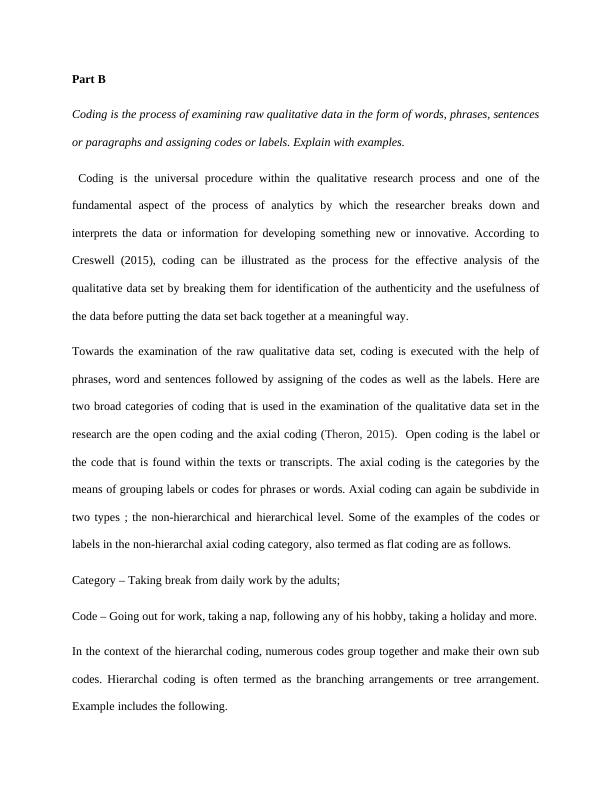
Category - Types of friendship
Code - Close friends, Work friends
Category - Friendship changes
Code -Losing touch, becoming lovers ; Sub-code applicable-New similar/different gender
friends
While locating meaning segmentation of data, coding is applied. Coding thus can be illustrated
as marking of the data segments with descriptive words , symbols or the names of the category as
highlighted above.
The process of coding thus includes the following steps. Firstly, while identifying any if the
meaningful segment of transcript or texts, code or the label needs to be assigned for signifying
that specific segment (Blair, 2015). On the second step, it is important to identify the relation
among the labels or the codes and then group them to categories of themes (example given
above). Finally the codes are being re applied towards new segments of the data every time when
encountered with appropriate segment.
Lewins, Taylor and Gibbs, (2005) in his research article provided a more detailed list regarding
the categories of things or segmentation which can be coded. Through out the illustration of the
examples, the researcher highlighted descriptive analysis of the codes. The examples of coding
together with the context of coding is stated below.
Context Things that can be coded Examples of coding
Activities Time consuming activities,
involvement of other people
Attending any course, Going
for clubbing
Code - Close friends, Work friends
Category - Friendship changes
Code -Losing touch, becoming lovers ; Sub-code applicable-New similar/different gender
friends
While locating meaning segmentation of data, coding is applied. Coding thus can be illustrated
as marking of the data segments with descriptive words , symbols or the names of the category as
highlighted above.
The process of coding thus includes the following steps. Firstly, while identifying any if the
meaningful segment of transcript or texts, code or the label needs to be assigned for signifying
that specific segment (Blair, 2015). On the second step, it is important to identify the relation
among the labels or the codes and then group them to categories of themes (example given
above). Finally the codes are being re applied towards new segments of the data every time when
encountered with appropriate segment.
Lewins, Taylor and Gibbs, (2005) in his research article provided a more detailed list regarding
the categories of things or segmentation which can be coded. Through out the illustration of the
examples, the researcher highlighted descriptive analysis of the codes. The examples of coding
together with the context of coding is stated below.
Context Things that can be coded Examples of coding
Activities Time consuming activities,
involvement of other people
Attending any course, Going
for clubbing

End of preview
Want to access all the pages? Upload your documents or become a member.
Related Documents
[PDF] Assignments on Research Methodslg...
|13
|4001
|359
Critical Analysis: Safety Checklist in Healthcare Improve Patient Safetylg...
|9
|2367
|108
Research Methods for International Staffing: Types of Research Methodologies, Sampling Techniques, and Data Analysis Techniqueslg...
|3
|508
|184
The Notion of Quantitative and Qualitative Divide in the Social Sciencelg...
|6
|1592
|83
Research Methods in Social Science: Quantitative vs Qualitativelg...
|15
|3923
|258
Differences Between Qualitative and Quantitative Research 2022lg...
|8
|1349
|26
